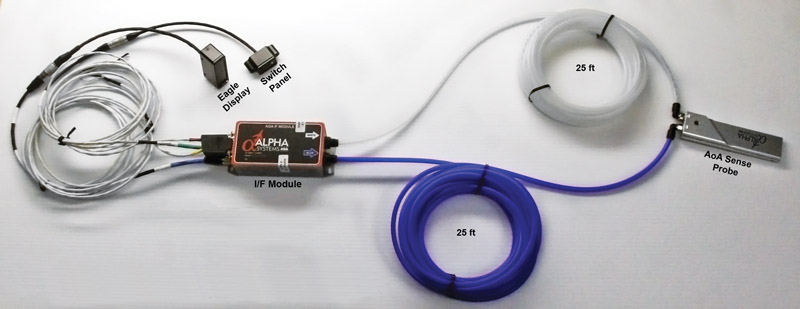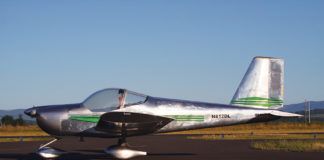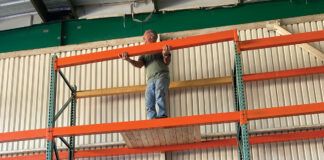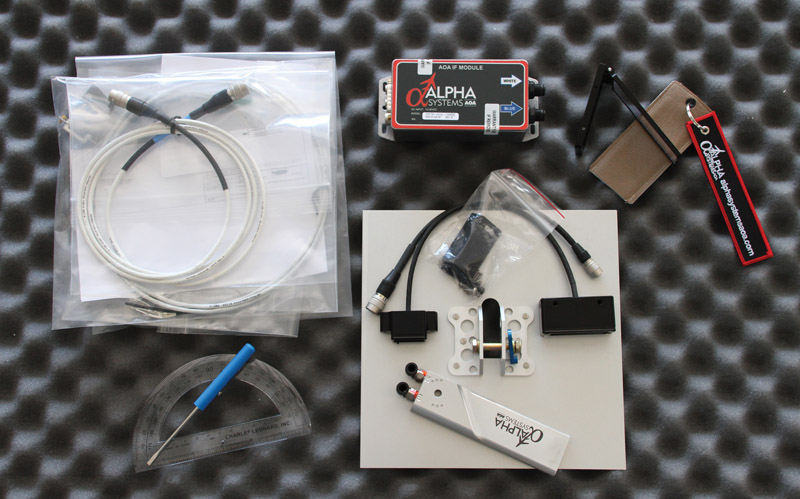
The complete Eagle kit (with Valkyrie HUD) includes the electronics module, control head, display, HUD, probe, and cables. Not shown, but included, is the probe tubing and plumbing.
While there are still those in aviation who sniff at the use of an angle-of-attack (AoA) system to provide a greater margin of safety and allow more precise flying, there is little doubt that knowing the exact angle of attack at any given moment accomplishes both of those things—and more. Yes, most people learn to fly without an angle-of-attack system, and yes, a good pilot should be able to feel an impending stall—but the records show that pilots continue to accidentally stall airplanes in moments of stress, and they do so because the venerable airspeed indicator we all learned with simply doesn’t tell us the whole truth. I happily still fly airplanes without AoA, but I am happier—and safer—if I have such a system.
With the advent of integrated EFIS (electronic flight instrument system) panels becoming the norm in Experimental aircraft, the use of AoA systems is increasing almost automatically, as all of the popular EFISes on the market can be configured to provide sensed or computed AoA for a very small premium in price. That means most builders are incorporating the instrumentation almost by default. But not every airplane has (or needs) an EFIS, and adding a full system just to get AoA is probably a bit foolish. For these cases, a standalone AoA system is still an excellent choice, and there are a number of them out there. We have reported on several of them in the past, and we were excited to get the chance to try the latest standalone system from Alpha Systems, a long-time builder of AoA devices, starting back when they were purely mechanical.
The system we installed—the Eagle—is the number one best seller in the Alpha Systems line. Combined with their Valkyrie HUD (heads-up display), it makes for a very slick installation that provides a wide variety of viewing angles and solid on-speed indication for approach and landing. The complete kit includes the wing-mounted pressure probe, electronics module, indicator, control head, and all of the connecting cables and plumbing required to install it in your airplane. At the time we received our kit, the price for the complete system was $1995, but check the Alpha Systems website for promotional deals that knock a couple hundred dollars off that price.
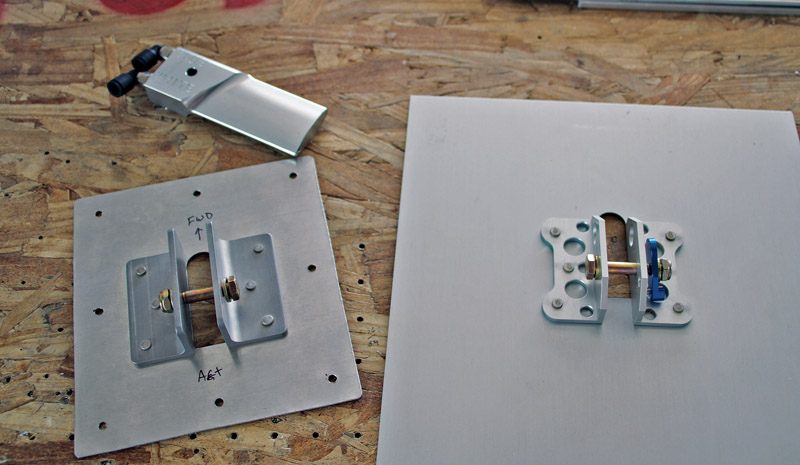
Since our aircraft had the old style probe installed already, we simply had to match drill and cut the mounting plate of the upgraded probe to fit the wing opening.
If you are currently building an airplane and want to prepare for the future installation of an Alpha Systems AoA without shelling out all of the money up front, you can buy their starter kit, consisting of the probe and plumbing so that all the future work can be done behind the panel. Included is all you need to put the probe on the wing and route the necessary pitot and AoA sense tubing all the way to the cockpit. This is priced at about $200—a very reasonable way to “future proof” your airplane for AoA. Interestingly enough, the airplane we installed the system on, our Dream Tundra, had the probe installed by the original builder about a decade ago—but for the earlier, all-mechanical-gauge version of Alpha Systems’ AoA. Upgrading from the early design to the latest electronic system required nothing more than installing the new electrical gear; the probe could have remained the same.
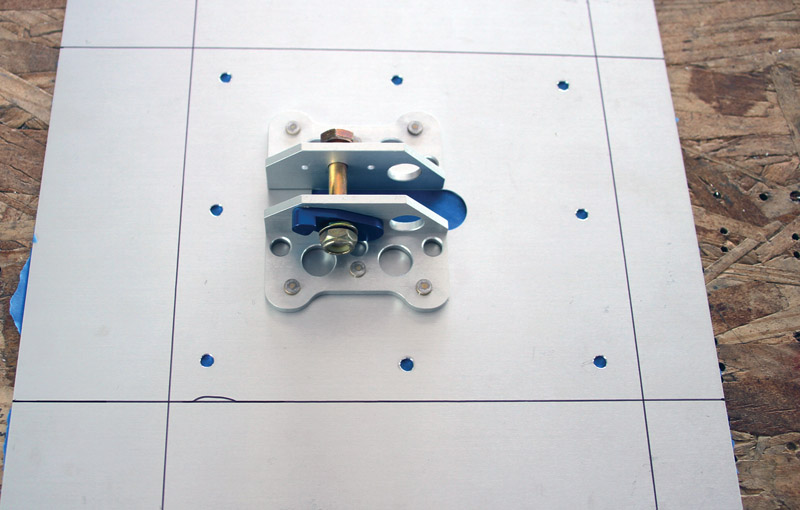
The new probe mounting kit includes an oversized plate that can be cut to whatever size and shape is required for the specific installation.
The indicator head for the Eagle system can be mounted on the panel, on the glareshield, or with the addition of the optional Valkyrie HUD, flush with the glareshield, pointed up. The HUD is a half-silvered mirror in a finely machined frame that then redirects the display into the pilot’s eyes as they look through it over the nose. The Valkyrie option raises the price by $500, but it does declutter the glareshield and looks amazing. The Eagle system works great either way, and the choice of installation is up to how you want your panel to look.
Installation
There is nothing tricky about installing the Alpha Systems AoA. The electronics module needs to be mounted somewhere out of sight, where it can connect to the two plumbing lines coming from the probe; but otherwise, any convenient spot will work. The choice of HUD or no HUD determines how the display will be mounted—either on top of the glareshield, or flush. You’ll need to find a small spot on the panel for the control head, but this will rarely be used after calibration and set up, so it doesn’t need prime real estate. It is also small, so it shouldn’t be hard to find a spot that works. All three of these electrical components are connected with pre-made cables provided in the kit—no pins or sockets need to be crimped or soldered. The pitot and AoA sense lines connect to the electronics module with easy quick disconnects; just cut the ends of the tubing square and push them into the sockets.
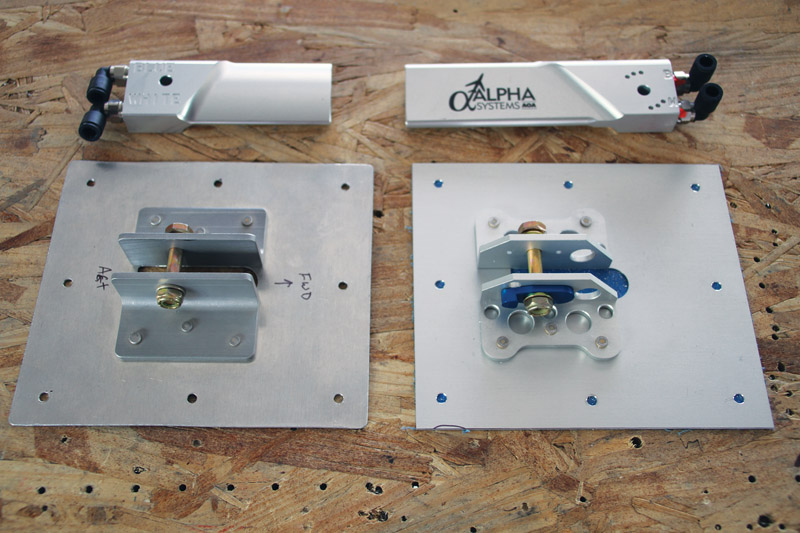
The new probe kit (on the right) has locking notches and tabs to preclude the probe from changing position if bumped.
The unit needs to be provided with power (12-28 volts) and ground, and there is an audio line you will need to connect to your aircraft’s audio panel—any unswitched audio input will do. We connected the power through an unused circuit breaker, allowing us to power the unit off for configuration work, or if required for some reason in flight. A fuse will work just as well.
The probe we had installed on the airplane for the original Alpha Systems mechanical indicator was an older design that allowed the probe to be oriented in an infinite number of positions within its range of motion. The latest version of the probe, allowed to be installed in certified aircraft, was required by the FAA certification folks to have positive locking in a smaller number of discrete positions so that it could not be accidentally bumped out of alignment. Alpha Systems, in an honest attempt at configuration control, asked that we return the old probe and install the new one so that they could be assured that all probes in the field will eventually be of the locking type. All this required of us was removing the eight machine screws holding the mounting plate in position, match drilling the new plate to the airframe, and reconnecting the new probe to the existing pneumatic tubes. It took longer to write that than it did to do it.
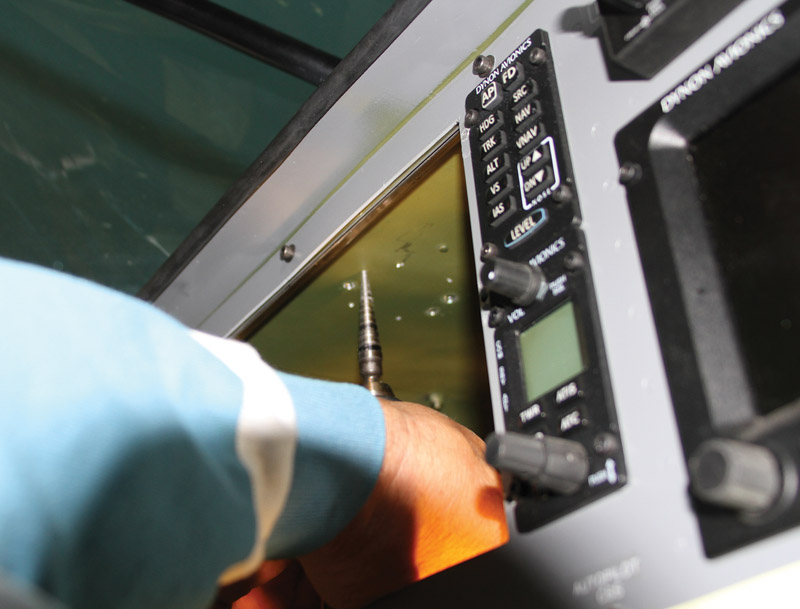
Cutting holes in the glareshield for the display unit is much easier if you have access through the front of the panel on a finished airplane.
Setting the new probe’s angle has to be done in advance of flight, as the locking feature requires that you pull the probe mounting plate, unfasten a bolt, then move the probe and tighten it back down. That’s probably a five-minute job, but the documentation provides a good guess at a starting point. We were fortunate in that once we got flying and did the electronic calibration, we found our probe was mounted “within range” so we didn’t have to mechanically change anything. Use the factory guidance, and we suspect that you too will be able to electronically calibrate the system without further adjustment of the probe. It’s almost a shame, as the adjustment and locking design is a work of art, and once you set it, you’ll never have to move it again.

A Dremel tool with a good cutoff disc makes quick work of cutting the rectangular opening for the display unit.
Since we were installing the HUD option, we needed to cut a hole in the glareshield the size of the indicator unit. Templates were provided, so it wasn’t hard to lay this out, and the use of an angle drill and Dremel tool with a good cutoff disc made the task go quickly. If you’re doing this on a completed aircraft as we were, using a vacuum cleaner while you do the cutting will make subsequent cleanup a lot easier. Using a piece of plastic as a “surgical drape” to cordon off the work area is also a good idea. Because our airplane has a 10-inch display unit installed directly in front of the pilot, it was a piece of cake to remove it and work through the very large opening in the panel. Working from underneath might be a bit trickier—but hey, we’re builders…right?
If you’re considering using the Valkyrie HUD, I’d suggest spending a little time sitting in the airplane first and evaluating the sight lines to see how well it will work—or at least understand what you’ll be seeing through the HUD. The perfect situation is that when you’re in piloting position, you don’t see any glareshield surface and look straight ahead to where the cowling isn’t in the way either. For this case, the ground or sky where you are pointed will be seen beyond the HUD image. In the case of many taildraggers (like our Tundra), we sit high enough (in order to see over the nose while taxiing) that we see the glareshield and a good portion of the top cowl. Our sight line through the HUD actually has us staring at the top of the cowl. However—and this is important—once in flight, the AoA indications are still clearly visible; they are just a little low in your field of vision. You won’t be staring through the middle of the HUD and seeing your landing aim point, but the careful use of display colors will still give you the cues you need.
Overall, installing the system is pretty low on the degree-of-difficulty scale, even for those who did not build their plane. Few special tools are required, and careful attention to measuring before cutting will make for a very neat and factory-looking install.
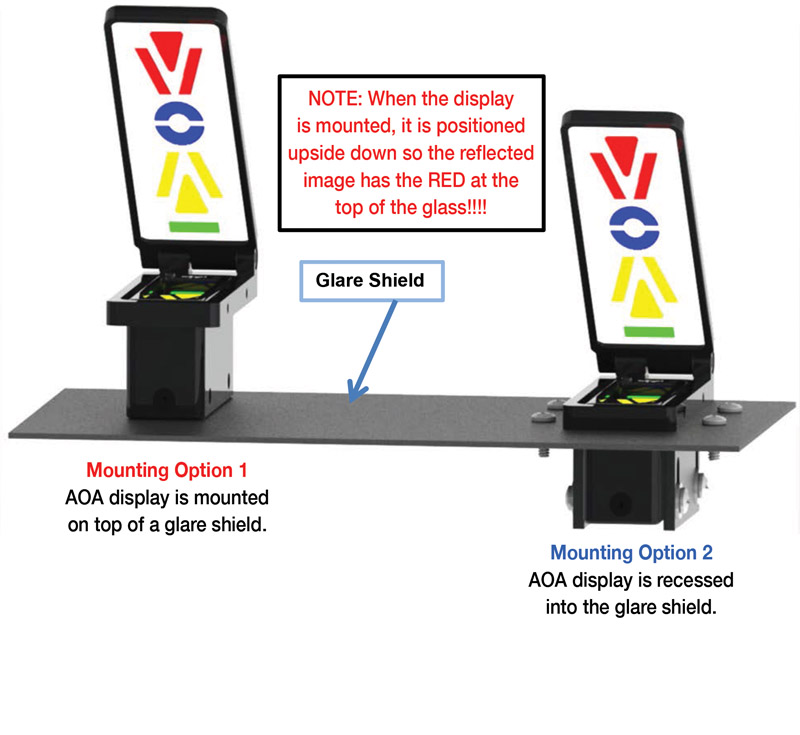
The Valkyrie heads-up display adapter and Eagle display can be mounted on top of—or recessed into—the glareshield. Once installed, the lens is tilted so the AOA display is reflected and viewed in the pilot’s peripheral vision. This allows the pilot to see through the glass and still see the colored segments.
Calibration
Like any AoA system, the electronics need to be calibrated to the specific airframe to account for unique installation geometry and airflow. Programming the unit requires a small jeweler’s screwdriver to turn a tiny selecting screw, then pushing an equally tiny button to select the mode and tell the unit to take a data point. This will be done on the control head, so hopefully you didn’t put it too far away from your field of view or reach.
The operations manual contains all of the detail necessary to successfully navigate your way through the process, and it pays to sit down and read through it a couple of times before attempting to fly. First, read through it to understand the overall process. Then read through it again and make notes of the actual steps that you need to take along the way, then go through it again and build yourself a cue card to use in flight to get the job done most efficiently.
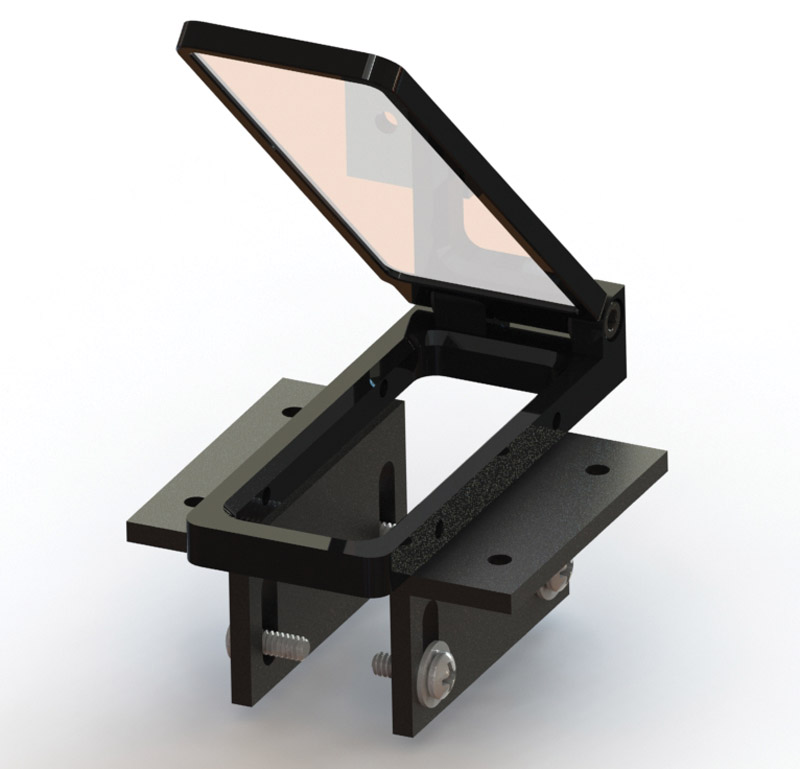
The Valkyrie HUD features a half-silvered mirror in a beautifully machined frame that mounts on top of the glareshield and to the hidden display unit. The angle of the mirror is adjustable in flight.
You’ll also need your headset and the audio system powered up, as the system gives you verbal prompts along the way. Visual cues are an option, but a poor one, as it is much more convenient to hear the voice tell you what it is doing along the way.
With the Alpha Systems AoA, this calibration begins on the ground, doing a check with zero airflow. You do this sitting in the hangar, with the doors closed and the system powered up. Select the appropriate spot with the selector screw, then hit the little SEL button. Follow the voice prompts, pushing the CAL button until it says that you have successfully calibrated the zero offset.

Final assembly of the display unit and HUD mirror, as seen through the windshield of the airplane. The HUD can be folded down when not in use.
Before you launch, take the time to calculate your optimum alpha angle (OAA) speed. This is basically 1.3 Vs, so you need to know your stall speed up front. Calculate it on the ground and write it down. Now once you get in the air and set up for the OAA calibration point, it is simply a matter of flying that speed and pushing the CAL button. If you are successful, you’ll be rewarded with the appropriate voice prompt. If the Cal fails, it is likely that you’ll have to land, get out a few tools, and reset the angle of the probe in the wing mount. The instructions guide you through this, but we had a successful calibration the first time.
The final data point you’ll take will be the cruise set point. Similar to the OAA point, you get the airplane stable in the desired configuration and then push the CAL button. There is a further step in the manual: saving the data. Don’t forget that, or you’ll have to start all over. It’s obviously something that people forget—there’s a two-thirds-of-a-page warning in the manual that you’re not done after the cruise set point—you have to save the data! It’s just another button push, so don’t forget it.
The manual also gives procedures for selecting brightness and audio levels, as well as selecting the audio modes. You can select whether you get tones or voices at various points in the AoA range. Since our aircraft also has an EFIS AoA with variable pulse rate tones, we elected to use the audio mode for the Alpha
Systems AoA that complemented that—the feminine voice that announces discrete points on the AoA spectrum.
Flying the Alpha Systems AoA
Once you have the system installed and calibrated, you can experience the benefits immediately. The center of the display is a blue circle—if you’re on speed (1.3 Vs), this will be lit up. Keep the blue circle lit up, and you’re right where you want to be. If you get fast, you’ll see an amber chevron below the blue circle pointing that you should pull up a little. If you get slow, a red chevron above the blue circle lights up, pointing down, which means push down. If you are in cruise, a green line underneath the whole display is lit up, showing that you are plenty fast.
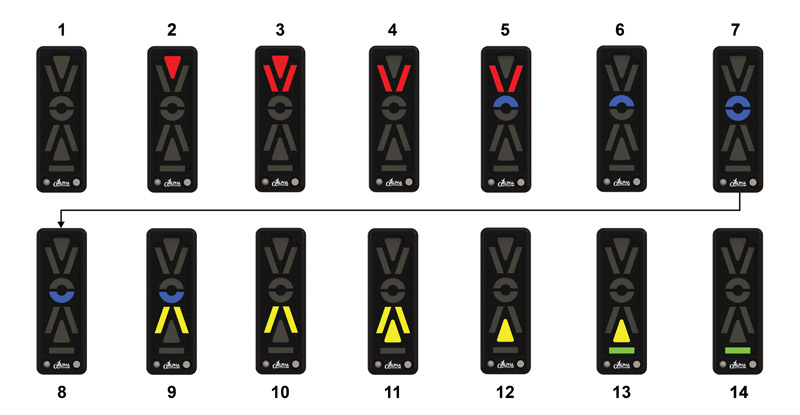
Flying an approach: Red chevron means you’re slow—push down. Blue circle means your speed is fine. Amber chevron means you’re fast—pull up. The green line appears during cruise, indicating you have plenty of speed.
Blue circle—on approach. Amber up chevron—pull up. Red down chevron—push down. That’s all there is to flying it!
Along with the visual cues, there are a couple of voice prompts in the mode we chose. A sweet voice announces “Getting slow” when getting to the blue donut point, and “Too slow” when the red chevrons illuminate. Coupled with the variable rate tones generated by our Dynon AoA, these discrete warnings do a good job of calling your attention to certain points in the landing phase.
A Useful Addition to the Quiver
Overall, we found the Alpha Systems unit to be an excellent AoA device. It’s easy to install, easy to calibrate, and accurate. If I was to be allowed only a single instrument in an airplane, I have to admit it would be an AoA. In the airplanes I regularly fly, with some sort of AoA installed, the only time I look at the airspeed indicator is to make sure I am below the top of the white arc to lower the flaps. “Approach speed” is really an approximation of where you want the AoA to be—and it varies with weight and G load.
Angle of Attack is not complicated, and the original system with a simple magnehelic gauge connected directly to the probe worked just fine. What it didn’t have was the ability to add audio and to mount it easily on the glareshield. Modern electronic systems give you those advantages, and yes, there is a cost—but not as much as adding a full EFIS display just to get the AoA function.
There are other standalone AoA systems available to the homebuilder—those from Advanced Flight Systems and BeLite come to mind—and there are homebuilt options available as well. They all add a margin of safety to every flight, and we encourage builders and pilots to add what they can afford.
The Eagle system from Alpha Systems is built from high-quality components and connectors, the kit is very complete, and the documentation is very thorough and well done, as you’d expect for a system that has been approved by the FAA for installation in certified aircraft. Whether you go with the top-end Eagle and the Valkyrie HUD or choose one of the less expensive options, the company is worth a look when looking for an AoA solution for your airplane or project.

